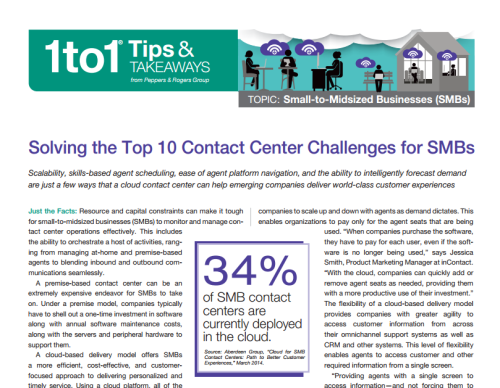If you have worked in a small to medium-sized contact center, you are probably familiar with challenges like capital constraints, agent scheduling, and managing inbound/outbound demands. These impediments can hurt the productivity of your call center and eventually hinder the achievement of your overall customer service goals.
Below we outline the Top 10 Challenges that SMB contact centers face in 2015 and how cloud technology can alleviate them.
1) Scaling Quickly to Meet Business and Call Volume Demands
Especially during the holidays and winter season, call volumes can spike dramatically for many call centers. With cloud contact center software, you can add and remove seats seamlessly while allowing agents the freedom to work remotely.
2) Integrating Products and Applications
Chances are you don’t have one solution for all of your contact center and customer service needs. Applications like Salesforce and Zendesk all require integration with your contact center software. With NICE, you’ll get custom CRM integration to make the process much easier.
3) Providing Ease of Navigation for Agents
When agents spend more time navigating through their contact center software, they are spending less time meeting the needs of their customers. An intuitive interface that presents the right information at the right time to your agents can mean the difference between a happy or an unhappy customer.
4) Increasing Supervisor Visibility into Contact Center Metrics
Some supervisors prefer a high-level look at their contact center, while others enjoy drilling down into very specific metrics. In either case, NICE’s cloud software platform can be customized to support both types of call center supervisors.
5) Accurate Forecasting of Demand
Forecasting demand in any business is difficult, but for call centers it can be even harder. With a robust set of analytics tools however, you can look at historical data and plan accordingly.
6) Intelligent, Skills-Based Agent Scheduling
Like all humans, agents have their strengths and weaknesses. Instead of trying to train all of your agents on all of the services your contact center provides, identify specialists in each area. With skills-based routing, you put your agents in a position to succeed. We call it the Workforce-Intelligent Contact Center.
7) Cutting the Cord
Supervisors are not meant to sit in front of a computer all day. Their responsibilities include helping on calls, agent scheduling, forecasting, and agent coaching. With a solution like our Supervisor-on-the-Go app, you can free your contact center leaders to roam the floor of the contact center, or keep a better eye on at-home agents.
8) Managing Multiple Contact Centers
Even though each individual contact center may be small, some small to medium size businesses do have multiple locations for their contact centers. Or, they may predominantly employ at-home agents who utilize their home offices. A cloud solution gives contact center managers the flexibility to send call traffic to different locations, or even to at-home agents.
9) Managing Inbound and Outbound Demands
If your contact center handles both inbound and outbound calls, you know the difficulty of trying to accurately forecast call volumes to make sure you are adequately staffed to handle customer service issues and meet sales goal. With a cloud ACD and IVR solution, you can easily switch your agents to handle inbound and outbound calls when needed.
10) Providing Omnichannel Support
In 2015, consumers are demanding support from every channel including phone, chat, email, social, and text. A cloud software platform easily handles all channels and supports your efforts to open all forms of communication with your customers.
Learn more about the NICE Call Center Software platform and download the Top 10 Challenges white paper today!





